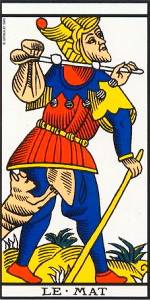The Fool (Zero)
From Wikipedia, the free encyclopedia.
The Fool is one the 78 cards in a Tarot deck. It is part of the major arcana section of the deck.
Contents |
Description and Symbolism
With light step, as if earth and its trammels had little power to restrain him, a young man in gorgeous vestments pauses at the brink of a precipice among the great heights of the world; he surveys the blue distance before him-its expanse of sky rather than the prospect below. His act of eager walking is still indicated, though he is stationary at the given moment; his dog is still bounding. The edge which opens on the depth has no terror; it is as if angels were waiting to uphold him, if it came about that he leaped from the height. His countenance is full of intelligence and expectant dream. He has a rose in one hand and in the other a costly wand, from which depends over his right shoulder a wallet curiously embroidered. He is a prince of the other world on his travels through this one-all amidst the morning glory, in the keen air. The sun, which shines behind him, knows whence he came, whither he is going, and how he will return by another path after many days. He is the spirit in search of experience. Many symbols of the Instituted Mysteries are summarized in this card, which reverses, under high warrants, all the confusions that have preceded it.
History
The "History of the Fool" from The Hermitage tells us that in the decks before Waite-Smith, the Fool is almost always unnumbered. There are a few exceptions: two old decks (including the Sola Busca) label the card with a "0", and the Belgian Tarot designs label the Fool as "XXII". The Fool is almost always completely apart from the sequence of trumps in the historic decks. Still there is historic precedent for regarding it as the lowest trump and as the highest trump!
In the game of tarot, the Fool has a unique role. Playing the Fool is like momentarily exempting yourself from the rules of the game.
Interpretation
In his Manual of Cartomancy, Grand Orient has a curious suggestion of the office of Mystic Fool, as apart of his process in higher divination; but it might call for more than ordinary gifts to put it into operation. We shall see how the card fares according to the common arts of fortune-telling, and it will be an example, to those who can discern, of the fact, otherwise so evident, that the Trumps Major had no place originally in the arts of psychic gambling, when cards are used as the counters and pretexts. Of the circumstances under which this art arose we know, however, very little.
The conventional explanations say that the Fool signifies the flesh, the sensitive life, and by a peculiar satire its subsidiary name was at one time the alchemist, as depicting folly at the most insensate stage.
Common to several tarot traditions is the idea that the fool is the traveller on the path of Tarot. The fool experiences every card.
Although it can not be seen in modern cards, the fool is often described as walking off a cliff. This raises the question "Is the fool making a mistake, or is the fool making a leap of faith?"
Another issue surrounding the fool is "Who is calling him The Fool?" Is it his contemperies?
Links and references
- A. E. Waite's 1910 Pictorial Key to the Tarot
- The History of the Fool Card from The Hermitage
This article incorporates text from the public domain 1910 book Pictorial Key to the Tarot by Arthur Edward Waite. Please feel free to update the text.


